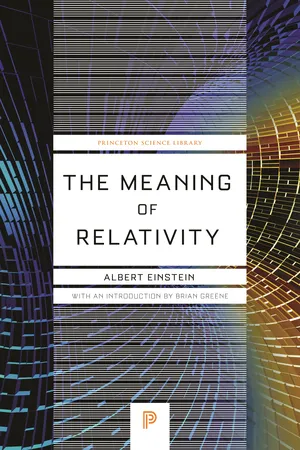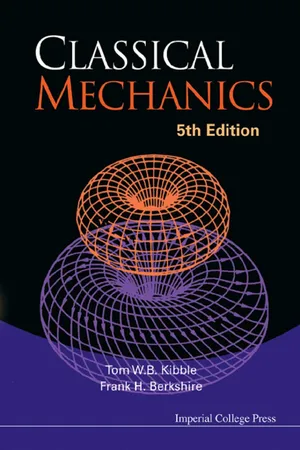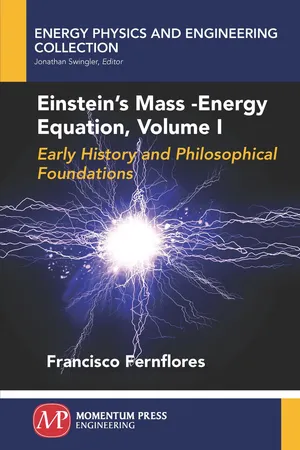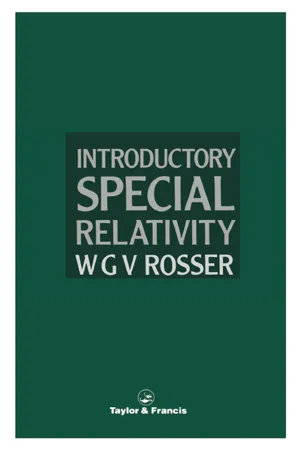Physics
Inertial and Gravitational Mass
Inertial mass refers to an object's resistance to changes in its state of motion, while gravitational mass relates to the strength of the gravitational force experienced by an object. These two types of mass are found to be equivalent in the theory of general relativity, which forms the basis for our understanding of gravity.
Written by Perlego with AI-assistance
Related key terms
Related key terms
1 of 4
Related key terms
1 of 3
9 Key excerpts on "Inertial and Gravitational Mass"
- eBook - ePub
Princeton Science Library
Including the Relativistic Theory of the Non-Symmetric Field - Fifth Edition
- Albert Einstein(Author)
- 2014(Publication Date)
- Princeton University Press(Publisher)
As long as the principle of inertia is regarded as the keystone of physics, this standpoint is certainly the only one which is justified. But there are two serious criticisms of the ordinary conception. In the first place, it is contrary to the mode of thinking in science to conceive of a thing (the space-time continuum) which acts itself, but which cannot be acted upon. This is the reason why E. Mach was led to make the attempt to eliminate space as an active cause in the system of mechanics. According to him, a material particle does not move in unaccelerated motion relatively to space, but relatively to the centre of all the other masses in the universe; in this way the series of causes of mechanical phenomena was closed, in contrast to the mechanics of Newton and Galileo. In order to develop this idea within the limits of the modern theory of action through a medium, the properties of the space-time continuum which determine inertia must be regarded as field properties of space, analogous to the electromagnetic field. The concepts of classical mechanics afford no way of expressing this. For this reason Mach’s attempt at a solution failed for the time being. We shall come back to this point of view later. In the second place, classical mechanics exhibits a deficiency which directly calls for an extension of the principle of relativity to spaces of reference which are not in uniform motion relatively to each other. The ratio of the masses of two bodies is defined in mechanics in two ways which differ from each other fundamentally; in the first place, as the reciprocal ratio of the accelerations which the same motive force imparts to them (inert mass), and in the second place, as the ratio of the forces which act upon them in the same gravitational field (gravitational mass). The equality of these two masses, so differently defined, is a fact which is confirmed by experiments of very high accuracy (experiments of Eötvös), and classical mechanics offers no explanation for this equality. It is, however, clear that science is fully justified in assigning such a numerical equality only after this numerical equality is reduced to an equality of the real nature of the two concepts.That this object may actually be attained by an extension of the principle of relativity, follows from the following consideration. A little reflection will show that the law of the equality of the inert and the gravitational mass is equivalent to the assertion that the acceleration imparted to a body by a gravitational field is independent of the nature of the body. For Newton’s equation of motion in a gravitational field, written out in full, is(Inert mass) . (Acceleration) = (Intensity of the gravitational field) . (Gravitational mass).It is only when there is numerical equality between the inert and gravitational mass that the acceleration is independent of the nature of the body. Let now K be an inertial system. Masses which are sufficiently far from each other and from other bodies are then, with respect to K, free from acceleration. We shall also refer these masses to a system of co-ordinates K′, uniformly accelerated with respect to K. Relatively to K′ all the masses have equal and parallel accelerations; with respect to K′ they behave just as if a gravitational field were present and K′ were unaccelerated. Overlooking for the present the question as to the “cause” of such a gravitational field, which will occupy us later, there is nothing to prevent our conceiving this gravitational field as real, that is, the conception that K′ is “at rest” and a gravitational field is present we may consider as equivalent to the conception that only K is an “allowable” system of co-ordinates and no gravitational field is present. The assumption of the complete physical equivalence of the systems of coordinates, K and K′, we call the “principle of equivalence;” this principle is evidently intimately connected with the law of the equality between the inert and the gravitational mass, and signifies an extension of the principle of relativity to co-ordinate systems which are in non-uniform motion relatively to each other. In fact, through this conception we arrive at the unity of the nature of inertia and gravitation. For according to our way of looking at it, the same masses may appear to be either under the action of inertia alone (with respect to K) or under the combined action of inertia and gravitation (with respect to K - eBook - ePub
Universe Dynamics
The Least Action Principle and Lagrange's Equations
- Jacques Vanier, Cipriana Tomescu (Mandache)(Authors)
- 2019(Publication Date)
- CRC Press(Publisher)
In the present model, an object is accelerated by the force of gravity given above. On the other hand, we have the law connected to inertia:(2.71)F =mai nwhereminis the inertial mass. The force of gravity is given by Eq. 2.70 . We thus conclude that an object of massmgrfalling towards the surface of the earth of massMesuffers an acceleration a in its fall to the earth’s surface. We thus have:(2.72)ma =i nmGg ro r a =M er 2Gmg rmi nM er 2The first obvious question, of course, relates to the difference between Inertial and Gravitational Masses, both being the content of matter in the objects in question. In fact, the physical concepts involved are totally different: they are inertia and gravity. Galileo, from experiments, concluded that those masses were identical. If we neglect friction due to the presence of air, there is no difference in acceleration between two objects falling to the surface of the earth from the same height, made of different materials, having different sizes and forms, or still having different weights, as measured with a spring balance. For example, take two balls of the same size and same weight and let them fall from a certain height. They arrive at the surface of the earth at the same time. Now, divide one of the balls into two smaller balls of half the original size, attach these three objects together with loose treads and let them fall from the same height. There will be no tension on the treads during travel and they will all arrive at the surface of the earth at the same time. It is said that Galileo had experimented this concordance from the Leaning Tower of Pisa. It was concluded that the acceleration due to gravity was identical for all falling objects and that inertial mass and gravitational mass were identical. This statement may be written as:(2.73)m=g rmi nalthough it should be recalled that the two masses represent two different entities and that the identity could be considered as resulting from a property characterizing space. This is a statement with extremely important consequences. It is part of the principle of equivalence. It says that the motion of objects in a gravitational environment is independent of their mass. There must thus be something that happens to spacetime to create that peculiar behavior: Einstein called it curvature. - eBook - ePub
- Hiqmet Kamberaj(Author)
- 2021(Publication Date)
- De Gruyter(Publisher)
weight are often interchanged with one another. But, in physics, their meanings are quite distinct.The mass measures the inertia of an object. As such, the mass is the resistance of an object to deviate from uniform straight-line motion under the influence of external forces. According to Newton’s second law, see eq. (5.7 ), if on two objects of different masses are acting forces of the same magnitude, then the object with smaller mass gains more acceleration than that of the object with larger mass. In other words, the object with larger mass exhibits a more significant resistance to deviate from its previous state of uniform motion in a straight line. Besides, in classical mechanics, the mass of an object represents an intrinsic property of the object, and hence it does not change if the object is moved to a different place.Consider an object with mass m as in Fig. 5.5 . We know that all objects are attracted to the Earth due to the force of gravity exerted by the Earth on an object,F g. The direction ofF gis toward the center of the Earth, and it has a magnitude, often called the weight of the object. We saw that a freely falling object experiences an acceleration g acting toward the center of the Earth. Applying Newton’s second law(5.15)F = m ato a freely falling object of mass m, witha = gandF =, we obtainF g(5.16)F g= m g .The block exerts this force to the supporting floor below it, which is stopping it from accelerating downwards. That is, the block exerts a downward forceF Won the supporting floor immediately beneath it. This force denotes the weight of the block. According to Newton’s third law, the ground below the block exerts an upward reaction forceF R - eBook - ePub
Information and the World Stage
From Philosophy to Science, the World of Forms and Communications
- Bernard Dugué(Author)
- 2017(Publication Date)
- Wiley-ISTE(Publisher)
The new interpretation taking shape at the moment splits physics into two categories: mechanics of arrangements and dynamics of information. The former dominates classical physics and the latter concretizes itself with the quantum theory of matter. Electromagnetic physics has remained ambiguous. It uses classic notions, fields and their influences (Coulomb, Maxwell), but the processes that it describes are not classic in the mechanical sense. The natural world in which we are evolving includes two kinds of forces, namely those whose essence is mechanical and those linked to electric charges. It is a strange nomological coincidence that the formula of electrostatic force is similar to that of gravitation. The first is proportional to the product of the two electric charges, q1 and q2. The second is proportional to the product of the masses, m1 and m2. The two are inversely proportional to the square of the distance. The fundamental difference is that gravitation attracts, whereas electric force attracts or repels according to whether the charges have identical or opposed signs.Mass is not reduced to a gravitational force which, incidentally, is not an actual force. We also know inertial mass. However, regardless of the nature of mass, we are dealing with a physics of forces, a type of mechanics and a science of arrangements. Cosmology studies the arrangement of masses in the universe. Rational mechanics studies several types of phenomena, such as how masses clash and transmit to one another a part of energy or impulse. Inertia designates nothing more than the resistance of a mass against any force attempting to move it. Hence, the formula that calculates the acceleration g based on the force F applied to a mass m is F = mg. Rational mechanics also studies another type of movement that differs from translation, namely rotation. Once again, in this case, the inertial mass is opposed to any force aiming to make a solid turn. In physics, mass is a property of matter that describes how material elements are arranged in space and opposed to forces (whichever their origin), and also how they generate forces such as gravitation forces.4.2. Electric charge, spin and dynamics of information
- eBook - ePub
- Serhii Stepanov(Author)
- 2018(Publication Date)
- De Gruyter(Publisher)
For example, the situation is exactly the same as that in the case of charge. However, there are still no consistent theories of mass quantization for particles similar to those available for the charge of particles (though things are not that straightforward with the latter, either).Many of the equations of classical mechanics include mass as a factor. For example, if u and a are the velocity and the acceleration of a particle, E and p are its kinetic energy and momentum, and F is the force exerted on the particle, then the following “definitions” of inertial mass are possible:m a = F ,m u = p ,m =.2 Eu 2Velocity and acceleration come from kinematics and thus reduce to measurements of length and time. Therefore, they are well-defined quantities in dynamics. However, the same cannot be said of force, momentum, and energy. Rather, they are defined in terms of mass. We could try to exclude dynamic quantities from the definition of mass. Suppose some standard force acts equally on two different masses m 1 and m 2 . For instance, it may be the force exerted by the first particle upon the second, which is equal to the inverse sign of the force exerted by the second particle upon the first (Newton’s third law). As a result of Newton’s laws, we have thatwhich is both a law of dynamics and a definition of a particle mass.m 1a 1= −m 2a 2,We will define mass using another method via the concept of elastic collision and some symmetry considerations. The inertial properties of mass are revealed when something changes the velocity of an object. This requires some impact from another object such as a collision.Suppose two different particles collide and then move apart along the same straight line. If the particles stay “the same” after the collision, the collision is called elastic - eBook - ePub
- Tom W B Kibble, Frank H Berkshire(Authors)
- 2004(Publication Date)
- ICP(Publisher)
It is an important general principle of physics (though not universally applied!) that no quantity should be introduced into the theory which cannot, at least in principle, be measured. Now, Newton’s laws involve not only the concepts of velocity and acceleration, which can be measured by measuring distances and times, but also the new concepts of mass and force. To give the laws a physical meaning we have, therefore, to show that these are measurable quantities. This is not quite as trivial as it might seem, because any experiment designed to measure these quantities must necessarily involve Newton’s laws themselves in its interpretation. Thus the operational definitions of mass and force — the prescriptions of how they may be measured — which are required to make the laws physically significant, are actually contained in the laws themselves. This is by no means an unusual or logically objectionable situation, but it may clarify the status of these concepts to reformulate the laws in such a way as to isolate their definitional element.Let us consider first the measurement of mass. Since the units of mass are arbitrary, we have to specify a way of comparing the masses of two given bodies. It is important to realize that we are discussing here the inertial mass, which appears in Newton’s second law, (1.1) and not the gravitational mass, which appears in (1.5). The two are of course proportional, but this equivalence principle is a physical law derived from experimental observation (in particular from Galileo’s observations of falling bodies, from which he deduced that in a vacuum all bodies would fall equally fast) rather than an a priori assumption. To verify the law, we must be able to measure each kind of mass separately. This rules out, for example, the use of a balance, which compares gravitational masses.Clearly, we can compare the inertial masses of two bodies by subjecting them to equal forces and comparing their accelerations, but this does not help unless we have some way of knowing that the forces are equal. However there is one case in which we do - eBook - ePub
- Francisco Fernflores(Author)
- 2017(Publication Date)
- Momentum Press(Publisher)
The first important lesson to glean from Cohen’s work is that in an earlier draft of Book I of Principia, Newton clearly illustrates the need to introduce a term other than “weight” to discuss a body’s resistance to changes in its state of motion. According to Cohen, Newton was aware that “weight” varies at different locations on earth. For Newton, “weight” is due to the force of gravity acting on an object, and it is this weight that Newton claims to have found, by experiment, to be proportional to a body’s “quantity of matter” [ 6, p. 87]. This is significant because it signals that prior to Newton there was not a single, widely used term with a prescribed meaning to refer to what we now call inertial mass. In the scholium to the definitions, Newton states “Thus far it has seemed best to explain the senses in which the less familiar words are to be taken in this treatise” [ 2, p. 408]. At the time Newton wrote Principia, the term “mass” was in this category of “less familiar words” whose meaning is in need of explanation. When we turn to the explanation that directly follows Definition 1 in Principia, we find three important aspects of the explication of the term “mass” that merit our attention. First, Newton lists a variety of examples of materials whose density is variable and for which the product of density times volume determines the amount of “stuff” present in a container. Newton explains: If the density of air is doubled in a space that is also doubled, there is four times as much air, and there is six times as much if the space is tripled. The case is the same for snow and powders condensed by compression or liquefaction, and also for all bodies that are condensed in various ways by any causes whatsoever [ 2, p. 403]. The role of the term “density” in this explanation is significant. The examples Newton provides involve cases in which one can reasonably imagine that the “matter” in question is composed of atomic (or at least individualizable) particles - eBook - ePub
- W G V Rosser(Author)
- 2017(Publication Date)
- CRC Press(Publisher)
−1 (the Earth turns through 360° in 24 h), so that the effects associated with the Earth’s rotation about its axis are generally very small. Effects due to the Earth’s rotation about the Sun are much smaller still (the Earth goes through 360° around the Sun in a year). Effects associated with phenomena such as the rotation of the Galaxy are very much smaller again. For most low-speed mechanical experiments a reference frame fixed to the Earth (which will be called the laboratory frame) is generally a satisfactory approximation to an inertial reference frame. The theory of special relativity is generally applied to optics, electricity and magnetism, and atomic and nuclear physics. The effect of the Earth’s rotation is usually negligible in all these cases, and the laboratory frame is almost invariably a satisfactory approximation to an inertial reference frame in which to apply the laws of optics, electricity and magnetism and atomic and nuclear physics.1.2.3 The measurement of force and massIn Newtonian mechanics the linear momentum p of a particle is defined as a vector, of magnitude equal to the product of the inertial mass m and the velocity u of the particle:p = m u .(1.3) Using Newton’s second law, the force f acting on a particle is defined as the rate of change of the momentum of the particle:f =dd t(.m u)(1.4) Assuming that the inertial mass of the particle is independent of its velocity, equation (1.4) can be written asf = mm a ,d ud t(1.5) where a is the acceleration of the particle. Hence force can be measured experimentally in terms of the acceleration that it produces on a body of known inertial mass; but before it can be measured in this way, one must know the inertial mass of the body. If equal forces act on two bodies of inertial masses m1 and m2 , producing accelerations a1 and a2 respectively, then, according to equation (1.5) , m1 a1 =m2 a2 , so that=m 1m 2a 1a 2(provided that)f 1=f 2(1.6) Newton’s third law states that action and reaction are equal and opposite. Hence, if the two bodies collide, the instantaneous values of the forces acting on the two bodies should be equal and opposite. Let a body of inertial mass m1 moving with velocity u1 collide head on with a body of inertial mass m2 that is at rest before the collision. Let both the bodies m1 and m2 move in the same direction after the collision with velocities u3 and u4 respectively. If f1 and f2 are the instantaneous values of the forces acting on m1 and m2 - No longer available |Learn more
- Robert A. Pelcovits, Joshua Farkas(Authors)
- 2023(Publication Date)
- Barrons Educational Services(Publisher)
3Newton’s Laws
Learning Objectives
In this chapter, you will learn:Newton’s three laws of motionMass vs weightApplication of Newton’s lawsNewton’s first law:Stated in words: When the net force acting on a body is zero, its acceleration must be zero, meaning that the velocity remains constant. This corresponds to two physical situations: (1) the object can either remain at rest (v = 0) or (2) continue along a straight-line path at constant velocity (v ≠ 0).Superposition of Forces What do we mean by net force? What happens if we exert several forces on a body at the same time? We find experimentally that the body behaves as if a single force is acting on it equal to the vector sum of all the individual forces (we call this vector sum the net force, Fnet ).The superposition of forces also works the other way, letting us treat each force as the sum of its components:When problem solving, we often combine these two approaches to add various forces together component-wise, obtaining a set of one-dimensional equations such as the following (which can then be related to the one-dimensional equations for uniformly accelerated motion).Concept of Inertia Inertia refers to how much an object resists a change in its velocity and is measured by mass. For example, it is easy to drastically change the velocity of an object with little mass or inertia (e.g., flicking a paper clip), but it is harder to change the velocity of an object with lots of mass or inertia (e.g., throwing a bowling ball).Corollary to Newton’s first law:What this equation means is that if an object is at rest (static equilibrium) or in motion with a constant velocity (dynamic equilibrium), it must have zero acceleration and zero net force. This equation is the basis of solving all static equilibrium problems involving particles.Newton’s Laws Are Valid Only in Inertial Reference Frames
Index pages curate the most relevant extracts from our library of academic textbooks. They’ve been created using an in-house natural language model (NLM), each adding context and meaning to key research topics.
Explore more topic indexes
Explore more topic indexes
1 of 6
Explore more topic indexes
1 of 4








